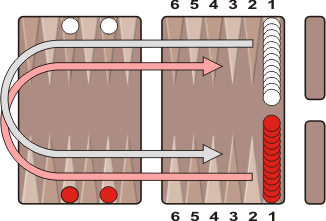![[Backgammon Galore!]](/gif/GaloreButton.gif)
|
|
Backgammon Variants Setup: Each player starts with thirteen checkers on the opponent's one-point, and one checker of each of the opponent's eight-point and ten-point. The checkers move in opposite directions as shown in the diagram below.
Object: The object of the game is to bring all of your checkers around to your own home board and then bear them off. The first player to bear off all their checkers wins the game. To start: Each player rolls one die and the higher number goes first. That player then rolls both dice again to begin his first turn. Movement: The roll of the dice indicates how many points, or pips, the player is to move his checkers. The following rules apply:
Pinning the opponent: There is no hitting in this game. Instead, if you land on a point occupied by a single opposing checker, the opponent's checker is trapped until you remove your checker. Two of your checkers on a point, or one of your checkers pinning the opponent's checker creates a block which the opponent cannot land or touch down on. Bearing Off: Once you have moved all fifteen of your checkers into your home board, you may begin bearing off. You bear off a checker by rolling a number that corresponds to the point on which it resides, then removing the checker from the board. If there is no checker on the point indicated by the roll, you must make a legal move using a checker on a higher-numbered point. If there are no checkers on higher-numbered points, you must remove a checker from the highest point that has a checker. Scoring: The winner scores one point for each pip that each loser's checker must travel to come home and bear off. For example, if the losing player finishes with a checker on the four-point and another checker on the six-point, the winner gets 10 points. If the loser has not borne off any checkers, he is gammoned and his pip total is doubled. If the loser has not borne of any checkers and still has a checker in the winner's home board or on the bar, he is backgammoned and pip total is multiplied by three. No doubling cube is used in the Pin Game.
References
|
![]()
Backgammon Galore : Variants

